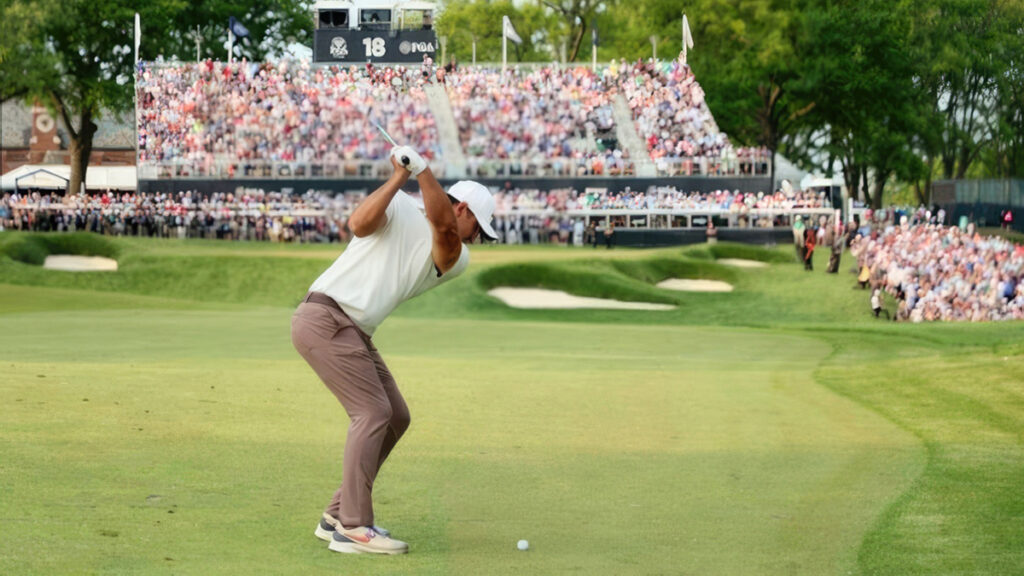Joel Dahmen aside, no player came through the first season of Netflix’s “Full Swing” docuseries with a more interesting character arc than Brooks Koepka.
Before, when Koepka reigned over golf, he was the one-dimensional tough guy. He wanted to be a baseball player growing up, not a golfer. He talked about the middle part of rounds being boring. He took joy in pushing the media around.
The Netflix show succeeded in pulling back the curtain on Koepka. It was only by having a front-row seat to a struggling Brooks Koepka that we came to realise he wasn’t the one-dimensional tough guy. He was the secretly sensitive guy. The tough guy exterior masked the existential insecurities he’s felt on the inside.
“I can’t compete with these guys week in, week out,” he admitted at one point in the show.
It was in Koepka’s heart and mind where he felt it, but it was his right knee that was the cause. A persistent injury and multiple surgeries had left him rattled, and in a constant state of worry.
It’s easy to forget at this point, but it was only May 2021 when Koepka, after wading through fans who surrounded the green moments before Phil Mickelson capped his historic PGA Championship victory, claimed one of them had “targeted” his knee in an attempt to re-injure it.
I was 10 feet away from Koepka during that moment. I didn’t see anything of the sort, and couldn’t comprehend any incentive why they would. Yet, it makes sense that he would earnestly feel that way. He was worried about his knee, and how could he not be?
And the interesting thing is that it showed up in his golf swing.

‘It was more of a Stack and Tilt’
Every golfer, on the backswing, shifts their weight onto their trail leg. It’s a key power generator, and it’s true for golfers of every level. But what changes is the amount of weight they shift onto their trail leg.
Basically, some golfers shift almost all their weight onto their trail leg. Some golfers shift less than half their weight. Everyone’s different.
Koepka is somewhere in the middle. He needs to load the right side a significant amount. The problem was, with his lingering knee issues, he was simply too worried to.
“When the knee was messed up, I was afraid to get back on it to load it on my right side,” he told me at the Masters. “It was more of a Stack and Tilt.”
And that, he said, created a series of problems. When he’d stay on his left side too much on his backswing, he’d compensate by reverse-pivoting.
“I was staying on the left side and I’d back up out of it,” he said. “Now it’s so much easier to be able to load, get that full turn and rotation going back. It’s tough when you’re just playing it on your left side – there’s no power there, either. That was the frustrating part.”
It’s hard to overstate how important this move is for him. Every golf swing is different, and Koepka needed to lead his trail leg a very specific amount in order to make his work. It was the glue that stuck his swing – and sticks yours – together.
“When Brooks stays too much on his front leg, it causes his clubface to close too early,” says Terry Rowles, a Golf Digest 50 Best Teacher. “That’s why he pulled it left. He lost his fade, it turned into a pull.”
That, ultimately, is what Koepka needed to overcome in order to get back to his best golf. It wasn’t that he physically couldn’t do it. It was that he was afraid to trust it. It took hard work, and it was only during the offseason that he made the breakthrough.
“I feel like I’ve done a good job of that this offseason being able to kind of do everything I need to do in the gym to get my knee more flexible and stronger,” Koepka said. “My right knee is better than my left. We’ve tested it, so it’s been kind of interesting.”
Interesting is right. It was technically a war between Koepka and his right knee. But really, it was one fought in his mind. A matter of trust, and belief. He’s won it now, and just as at Oak Hill in May, it’s the winners who write the history.

